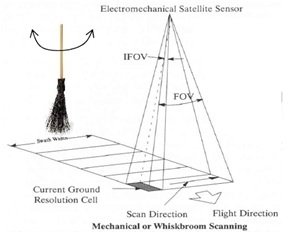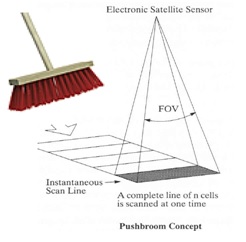Push Broom and Whisk Broom Sensors
Anonym
We've been doing a lot of cleaning in Boulder this week, after our historic flood. Perhaps not coincidentally, I've been thinking about some cleaning tool terminology commonly used in the remote sensing world. Specifically, I've been thinking about the two types of sensors commonly used for passive, optical, satellite imaging: push broom and whisk broom. As anyone facing any type of complicated task can tell you, it is important to understand your tool. Knowing which type of scanner collected your imagery can help you better understand your data and how to work with it.
Whisk Broom Scanners
Whisk broom scanners, also sometimes referred to as spotlight or across track scanners, use a mirror to reflect light onto a single detector. The mirror moves back and forth, to collect measurements from one pixel in the image at a time ( Fig. 1). The moving parts make this type of sensor expensive and more likely to wear out.

Figure 1. A whisk broom scanner sweeps in a direction perpendicular to the flight path, collecting one pixel at a time. Image courtesy of Florian Hillen.
All Landsat sensors prior to Landsat 8 use the whisk broom design. (The OLI instrument on Landsat 8 uses a pushbroom design.)
Push Broom Scanners
Push broom scanners, also sometimes referred to as along track scanners, use a line of detectors arranged perpendicular to the flight direction of the spacecraft. As the spacecraft flies forward, the image is collected one line at a time, with all of the pixels in a line being measured simultaneously (Fig. 2). A push broom scanner receives a stronger signal than a whisk broom scanner because it looks at each pixel area for longer. One drawback of push broom sensors is that the detectors in the "push broom" can have varying sensitivity. If they are not perfectly calibrated, this can result in stripes in the data.

Figure 2. A linear array detector advances with the spacecraft's motion, producing successive lines of image data (analogous to the forward sweep of a push broom). Image courtesy of Florian Hillen.
Sensors that use the push broom design include SPOT, IRS, QuickBird, OrbView, and IKONOS.